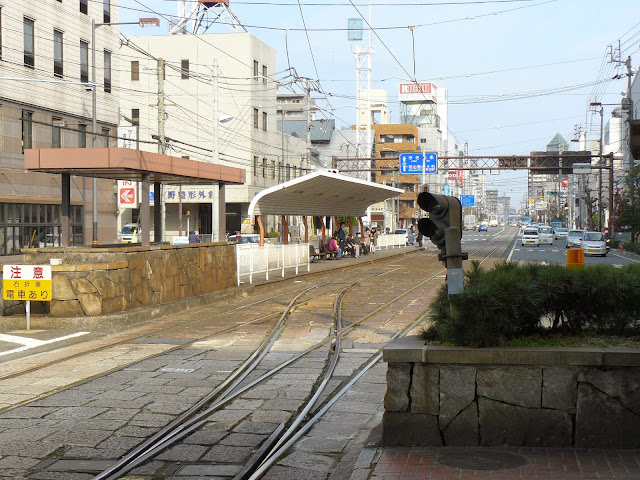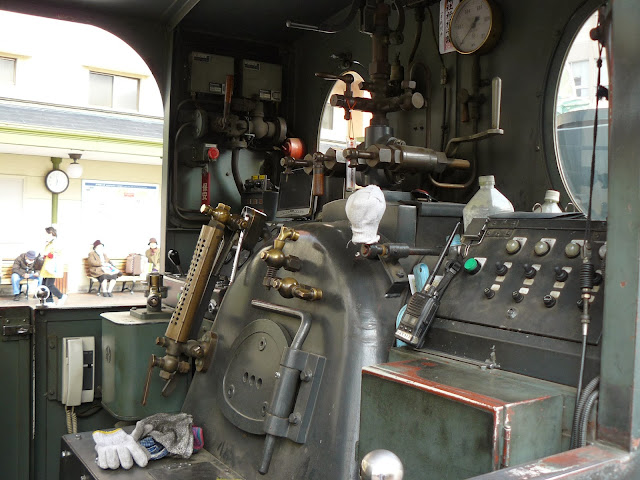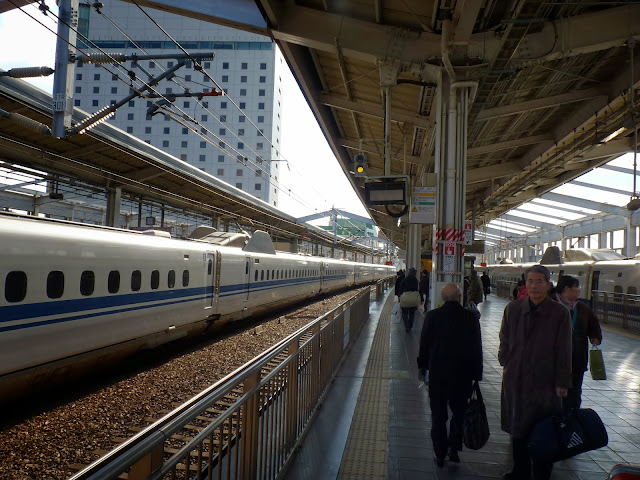The next part of our Shikoku trip involved taking the JR Shikoku tilt train (above) from Takamatsu to Matsuyama, which takes a couple of hours, mostly travelling along the scenic Shikoku coastline. I had never been on a tilt train before so I was very excited to experience a journey on one.
Here is the Takamatsu Station platform sign next to the train:
Here is a closeup of the JR Shikoku logo:
We were in carriage no. 1 for this trip:
Inside the train my attention was first drawn to the beautiful washroom sinks. It is rare to see this sort of washroom bowl on a train:
We then took our seats and here is the view from the inside of the carriage:
The seats were comfortable, can tilt and rotate 180 degrees if you have 4 friends travelling together for example. Here is some of the scenic views of the mountains as we headed towards Matsuyama:
We eventually arrived at Matsuyama station:
Looking around Matsuyama Station I could see some of the other local trains:
Outside Matsuyama Station:
Near to Matsuyama station is the tram stop heading towards Dogo Onsen, our primary destination in Matsuyama. Here is the view from the tram stop:
Matsuyama is far from the larger cities of Japan, and the age of some of the trams running there reflects this, and also the general absence of English explanations:
The tram I wanted to catch wasn't due for a while so I went tram spotting. There are some modern trams too:
However, the tram I wanted to ride is the Bocchan Resha. It is a replica of the original steam train series and wooden carriages used in Matsuyama, but updated to use Matsuyama tram lines and runs a diesel engine and smoke effects (with electric pantograph power to conform to Automatic Train Stop ATS - regulations). They are quite narrow but the Bocchan Resha looks fantastic:
Bocchan Resha rear view heading towards Matsuyama Station tram stop:
Here is a few more modern and older tram models running in Matsuyama:
Back at the Matsuyama tram stop, the Bocchan Resha is about to arrive - you can see how narrow and small it is compared to the tram next to it:
The entry door to the narrow wooden carriages is very low and of course I hit my head on the top of the door frame trying to get inside with our luggage in tow. They reckon 8 people can sit in here but I personally doubt that claim!
The original plate from the construction of the Bocchan Resha in Germany back in 1888 is shown here:
After a short 30 minute trip we arrived at Dogo Onsen tram stop. It is a beautiful station:

Having got off the Bocchan Resha, a surprise awaited as the loco then separates from the carriages and shunt to a special location just beyond the station where a man can lift and turn the loco around on the railway line by himself, and then reconnect the loco to the carriages for it's return journey! Very interesting!
Here is the train, all turned around and reconnected ready to go back to Matsuyama station:
Here is a closer look at the Bocchan Resha loco:
If you visit Matsuyama, make sure you take the time to ride the Bocchan Resha, it is a very interesting train. There is a staff member in period costume on the train who explains the history of the train - it was all in Japanese though - my wife was kind enough to translate it for me!
Dogo Onsen is the oldest bathhouse in Japan, over 3000 years old. Until very recently, this was the bathhouse used by the Emperor of Japan, and you can still use the public baths in it today:
Some interesting decorations on the fence surrounding Dogo Onsen:
Near the Dogo onsen station is this rather neat clock tower, which has an interesting display that occurs each hour:
We stayed in a beautiful luxurious Ryokan near Dogo Onsen, which was very relaxing and included a huge 3 hour dinner course! It had two baths in the room, one small and one bigger:
These baths have water supplied from hot springs below the surface and supposed to have special properties to help you relax - it certainly worked for me!
This was the view from the bedroom out past the onsen to the view outside:
Here is one course of the MANY courses we had for dinner that night in the Matsuyama Ryokan. It was delicious:
The next day we headed back to Tokyo, taking the the same tilt train service from Matsuyama Station, which continues past Takamatsu and continues on to Okayama. Here is the ekiben (Railway Station lunchbox) we bought at Matsuyama Station for the trip, train themed of course:
Along the way we saw some breathtaking scenery approached the bridge between Shikoku and the main Honshu mainland:
The view got even better as we crossed the bridge itself - the weather is clear and looked great:
The bridge is very high up and this view demonstrates that quite well:
At Okayama Station, we then waited a short time for the Tokaido Shinkansen to take us back to Tokyo, which takes a couple of hours to get there:
It was a fantastic trip, and I was very glad to see and ride a lot of interesting trains along the way! I hope this inspires people to come and visit Shikoku! :-)
















































































